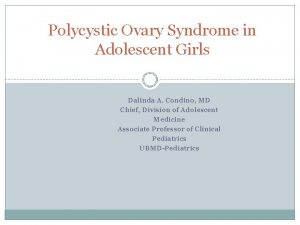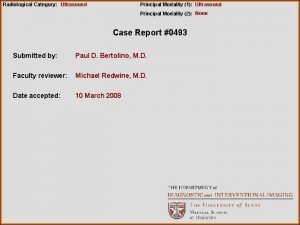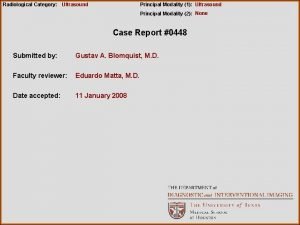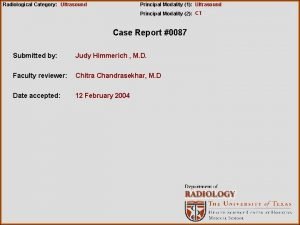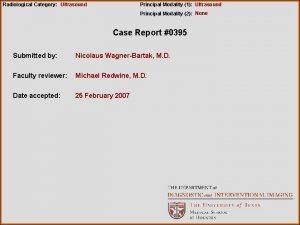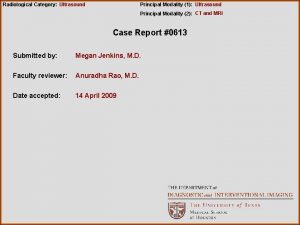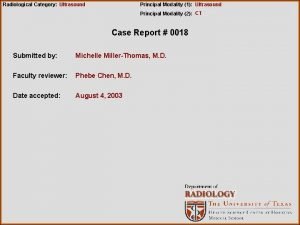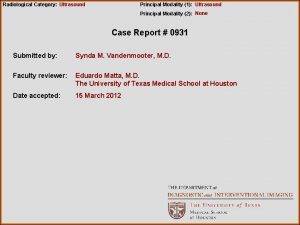Radiological Category Ultrasound Principal Modality 1 Ultrasound Principal









- Slides: 9

Radiological Category: Ultrasound Principal Modality (1): Ultrasound Principal Modality (2): None Case Report # 0095 Submitted by: Lumarie Santiago, M. D. Faculty reviewer: Phebe Chen, M. D. Date accepted: 12 March 2004 This case report was presented at the 51 st annual meeting of the Association of University Radiologists, 12 April 2003, 12 th Annual Kay Vydareny Film Interpretation Competition.

Case History 35 year old man with left calf pain.

Radiological Presentations Longitudinal Transverse POPLITEAL ARTERY Color Doppler Longitudinal

Test Your Diagnosis Which one of the following is your choice for the appropriate diagnosis? After your selection, go to next page. • Ruptured Baker’s cyst • Thrombosed popliteal artery aneurysm • Popliteal entrapment • Adventitial cystic disease

Findings and Differentials Findings: Multi-lobulated cystic structures encasing the popliteal artery without internal vascularity or narrowing of the popliteal artery lumen. Differentials: • Ruptured Baker’s cyst • Thrombosed popliteal artery aneurysm • Popliteal entrapment

Discussion Claudication typically presents as exercise induced leg pain that improves after rest. It is associated with risk factors like high blood pressure, smoking, hypercholesterolemia and diabetes. Patients with adventitial cystic disease of the popliteal artery typically present with sudden onset of claudication but do not have the risk factors commonly associated with claudication. Patients are usually young males less than 50 years old. Symptoms are unilateral and no palpable abnormalities are found on physical exam. Ultrasound demonstrates multilobulated cysts arising from the wall of the artery. The arterial flow and lumen are preserved. On angiography, there is focal, smooth tapered stenosis at the level of the femoral condyles (see next page for images). The etiology of the cysts is uncertain but are thought to be secondary to trauma to the adventitia from repetitive flexion. They may also represent inclusion remnants from mucous secreting synovium or myxoid degeneration of the arterial wall. Ruptured Baker’s cyst presents as a palpable fullness in the popliteal fossa. If intact, it presents as a discrete hypoechoic structure. When ruptured no discrete cystic structure can be identified and the fluid dissects into the calf but usually superficial to the popliteal artery. Thrombosed popliteal artery aneurysm may have a fusiform or saccular configuration. The thrombus is located within the lumen with the wall of the artery conforming to the aneurysmal dilatation.

Discussion Focal, smooth narrowing at the level of the femoral condyles. Image by James S. T. Yao, Vascular. Web 2004. Northwestern University Medical School Chicago, Illinois

Discussion • Yao, J. S. T. Popliteal artery adventitial cystic disease-diagnostic image. Vascular. Web. 2004 • Ricci P. , Panzetti, C. , et al. Cross-Sectional Imaging in a Case of Adventitial Cystic Disease of the Popliteal Artery. Cardiovascular Interventional Radiology. 1999; 22: 71 -74. • Brodmann M. , Stark G. , et al. Cystic Adventitial Degeneration of the Popliteal Artery-the Diagnostic Value of Duplex Sonography. European Journal of Radiology. 2001; 38: 209 -212.

Diagnosis Adventitial cystic disease of the popliteal artery.
 Pcos ultrasound vs normal ultrasound
Pcos ultrasound vs normal ultrasound Erate category 2 eligible equipment
Erate category 2 eligible equipment Radiological dispersal device
Radiological dispersal device Tennessee division of radiological health
Tennessee division of radiological health Center for devices and radiological health
Center for devices and radiological health National radiological emergency preparedness conference
National radiological emergency preparedness conference Sodality vs modality
Sodality vs modality One to many relationship line
One to many relationship line Epistemic modality
Epistemic modality Cardinality and modality
Cardinality and modality
